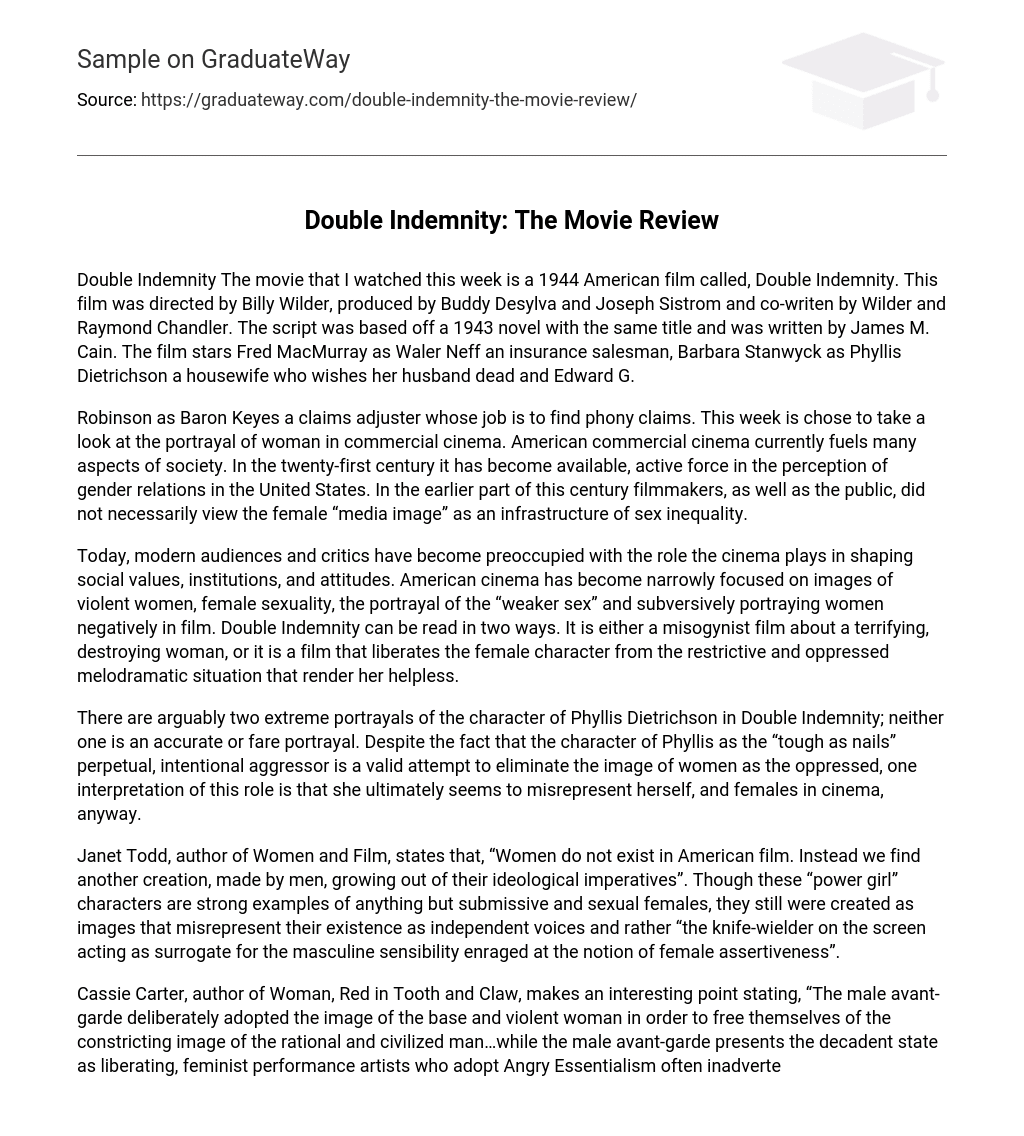Double Indemnity The movie that I watched this week is a 1944 American film called, Double Indemnity. This film was directed by Billy Wilder, produced by Buddy Desylva and Joseph Sistrom and co-writen by Wilder and Raymond Chandler. The script was based off a 1943 novel with the same title and was written by James M. Cain. The film stars Fred MacMurray as Waler Neff an insurance salesman, Barbara Stanwyck as Phyllis Dietrichson a housewife who wishes her husband dead and Edward G.
Robinson as Baron Keyes a claims adjuster whose job is to find phony claims. This week is chose to take a look at the portrayal of woman in commercial cinema. American commercial cinema currently fuels many aspects of society. In the twenty-first century it has become available, active force in the perception of gender relations in the United States. In the earlier part of this century filmmakers, as well as the public, did not necessarily view the female “media image” as an infrastructure of sex inequality.
Today, modern audiences and critics have become preoccupied with the role the cinema plays in shaping social values, institutions, and attitudes. American cinema has become narrowly focused on images of violent women, female sexuality, the portrayal of the “weaker sex” and subversively portraying women negatively in film. Double Indemnity can be read in two ways. It is either a misogynist film about a terrifying, destroying woman, or it is a film that liberates the female character from the restrictive and oppressed melodramatic situation that render her helpless.
There are arguably two extreme portrayals of the character of Phyllis Dietrichson in Double Indemnity; neither one is an accurate or fare portrayal. Despite the fact that the character of Phyllis as the “tough as nails” perpetual, intentional aggressor is a valid attempt to eliminate the image of women as the oppressed, one interpretation of this role is that she ultimately seems to misrepresent herself, and females in cinema, anyway.
Janet Todd, author of Women and Film, states that, “Women do not exist in American film. Instead we find another creation, made by men, growing out of their ideological imperatives”. Though these “power girl” characters are strong examples of anything but submissive and sexual females, they still were created as images that misrepresent their existence as independent voices and rather “the knife-wielder on the screen acting as surrogate for the masculine sensibility enraged at the notion of female assertiveness”.
Cassie Carter, author of Woman, Red in Tooth and Claw, makes an interesting point stating, “The male avant-garde deliberately adopted the image of the base and violent woman in order to free themselves of the constricting image of the rational and civilized man…while the male avant-garde presents the decadent state as liberating, feminist performance artists who adopt Angry Essentialism often inadvertently reinforce a conception of the ‘feminine’ which validates the oppression of women”.
Carter then further states, “While these performances attempt to obliterate the image of woman as the oppressed, nurturing Earth Mother, they merely invoke her mirror image, the Devouring Mother”. Double Indemnity, in its attempt to lend its female character more strength and control, no longer situating her as the secure center of the family, but rather its destroyer, ironically seems to highlight a played-out submissive, weak, abused or lonely and alienated image of Phyllis. The varieties of passive, subordinate or pacified women are classic throughout the history of film.
Janet Todd states, “Film teaches us how to see and understand from the point of view of the dominant, male-orientated ideology”. Cinema has found an audience for the portrayal of the “weaker sex”. This is an example of cinema’s skewed portrayal of “womanhood” in film, which is often misrepresented as “homely” or “motherly”. Though this may be a characteristic of the female instinct in some instances, it is not a good generalization. For example, Timmy’s mother in the popular series Lassie, or Mrs. Cleaver in the classic Leave it to Beaver, are featured almost all of the time in the kitchen cooking or busy with duties around the household.
In fact, if these type characters are not featured in the kitchen during the actual act of cooking, cleaning, etc. … they are almost always seen, at any given time, wearing the classic dress and apron attire. Todd also reminds us “Since women constitute more than half that public, we are faced with the troubling reality of an audience passively, even willingly, accepting roles of its own degradation”. These are extreme examples in classic film but they do illustrate to viewers how Hollywood seems to be so identified with the maternal and simple values of these women.
Molly Haskell, author of, From Reverence to Rape, points out, “According to society’s accepted role definitions, which films have always reflected in microcosm, a woman is supposedly most herself in the throes of emotion (the love of man or of children), and least herself, that is least “womanly”, in the pursuit of knowledge or success”. These types of roles are so common we accept that these characters are distressingly naive and so fail to stun audiences, yet again, with the shimmering intelligence and ingenue of an interesting female role in cinema.





